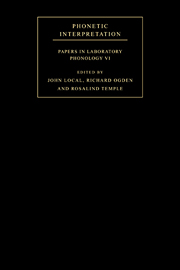Book contents
- Frontmatter
- Contents
- List of contributors
- Acknowledgements
- Introduction
- Part I Phonological representations and the lexicon
- Part II Phonetic interpretation and phrasal structure
- Part III Phonetic interpretation and syllable structure
- 11 On the factorability of phonological units in speech perception
- 12 Articulatory correlates of ambisyllabicity in English glides and liquids
- 13 Extrinsic phonetic interpretation: spectral variation in English liquids
- 14 Temporal constraints and characterising syllable structuring
- 15 Commentary: some thoughts on syllables: an old-fashioned interlude
- Part IV Phonology and natural speech production: tasks, contrasts and explanations
- References
- Index of names
- Index of subjects
15 - Commentary: some thoughts on syllables: an old-fashioned interlude
Published online by Cambridge University Press: 22 September 2009
- Frontmatter
- Contents
- List of contributors
- Acknowledgements
- Introduction
- Part I Phonological representations and the lexicon
- Part II Phonetic interpretation and phrasal structure
- Part III Phonetic interpretation and syllable structure
- 11 On the factorability of phonological units in speech perception
- 12 Articulatory correlates of ambisyllabicity in English glides and liquids
- 13 Extrinsic phonetic interpretation: spectral variation in English liquids
- 14 Temporal constraints and characterising syllable structuring
- 15 Commentary: some thoughts on syllables: an old-fashioned interlude
- Part IV Phonology and natural speech production: tasks, contrasts and explanations
- References
- Index of names
- Index of subjects
Summary
Two of the three papers in this group have at their centre the nature of the syllable. Gick's paper focuses on ambisyllabicity, and de Jong discusses phonetic characteristics of syllable structure. The third paper, Carter's, is more concerned with segmental characteristics, but he, too, makes extensive use of distinctions between syllable onset and coda position. Gick's and de Jong's papers assume that syllables should have universal phonetic exponents, although, as de Jong puts it, ‘an explicit and simple characterisation of the phonetics of syllables has yet to be found’. Carter would probably join me in saying that it may not be possible to find universal properties of syllables, because they are local phonological constructs with no general phonetic properties.
I will begin by discussing Carter's paper on liquids. This paper is very clear and complete. As an experimentalist, I would like to have seen data from more than a single speaker from each dialect. It is possible that people who have velarised initial laterals and speak nonrhotic dialects all behave like the Mancunian speaker that Carter recorded. But, as de Jong reports in his paper discussing only four speakers, there may be differences among speakers that force one to reconsider one's previous assumptions. Nevertheless the elegance of Carter's experimental design has resulted in data that are indicative of relations among liquids that are of great interest.
Carter forces us to realise the importance of considering different dialects of English.
- Type
- Chapter
- Information
- Phonetic InterpretationPapers in Laboratory Phonology VI, pp. 269 - 276Publisher: Cambridge University PressPrint publication year: 2004



